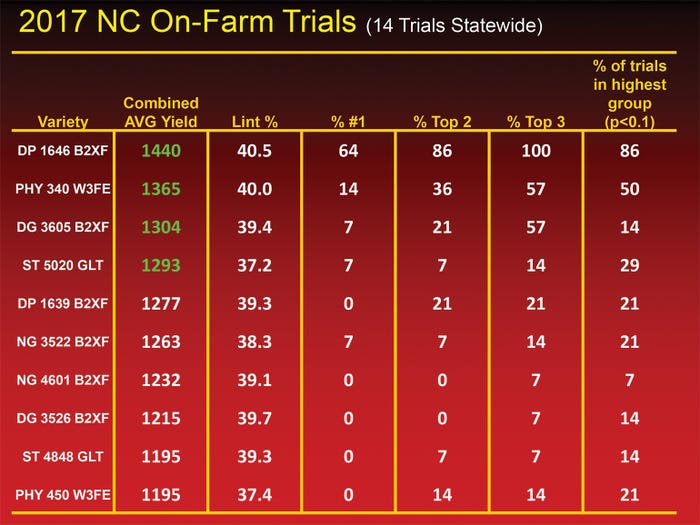December 4, 2017

North Carolina cotton growers harvested high-yielding quality fiber in 2017, something they needed badly after facing two straight years of untimely flooding and other yield-dropping conditions.
“We are thankful to harvest high yields in most areas of our cotton-producing areas while avoiding any majorly destructive weather during the fall months. The yield results are now available from the 2017 On-Farm Cotton Variety Evaluation Program!!” Guy Collins, NC State cotton specialist, enthusiastically posted to the NC State cotton page
The on-farm program consists of the most widely adapted and best-suited varieties for North Carolina cotton growers as determined by leading seed companies, he says. Collins advises variety decisions be based on multi-environment and multi-year replicated data in order to identify varieties with a high degree of stability (strong performance across a wide range of environmental conditions and years).
The slide below gives a general summary of variety performance across North Carolina, but he said the results of the trial will be discussed in greater details, and recommendations given, during the coming winter cotton-meeting season, which will be announced soon.

In this slide, varieties are ranked in descending order according to average yield across all trials in the analysis. Varieties with yields highlighted in green indicate that yields were above average across locations. The percentage of trials in which a variety performed at the top, within the top 2, within the top 3, and most importantly within the statistically highest yielding group are also shown.
“It is important to note that lint yields were thankfully higher than normal this year, which is great for our state, however this leaves us with little assessment of variety performance in droughty conditions for brand new varieties especially,” he says. “Additionally, yield limiting factors such as bollworms clearly impacted variety performance in a few places this year, and this will be discussed during the winter meetings.
“As mentioned earlier, individual trial results can be obtained from your local county agent and in the variety calculator. Results for OVT and fiber quality will be available soon. Growers are also encouraged however to observe multi-location and multi-year data before making variety decisions,” he says.
He says growers should focus more on factors such as stability characteristics, regional performance, positioning varieties in specific types of environments and understanding yield-limiting factors such as drought stress during early bloom and potential impacts of bollworms, versus focusing on the overall variety ranking.
As a standard practice, it is always wise for growers to choose several varieties and position those varieties in environments where they are likely to perform competitively. It is also advised that growers observe data from both the on-farm program and NCSU Official Variety Trials, which will be available soon, he says.
In his post, Collins says the on-farm evaluation program success is due to “substantial support from the NC Cotton Producers Association, NCDA&CS, NC State University, our Seed Companies, and Cotton Incorporated.
“This program was only made possible through their leadership and support, and the significant effort from our county agents, consultants, and cooperating growers through implementing this program in 15 trials across the state. The contributions of all involved are much appreciated, and will have significant impact on our growers’ bottom line as we look forward to 2018,” he says.
About the Author(s)
You May Also Like






